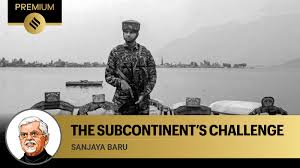09 May 2025 Indian Express Editorial
What to Read in Indian Express Editorial( Topic and Syllabus wise)
Editorial 1 : Give Back their Childhood
Context: Child labour in India
Introduction: In a country with 35.6 million unemployed adults, there are 7.8 million children working. Let the adults do the work and let the children go to school.
Current State of Child Labour in India
- Statistics
- 18 lakhs as per national definition to 33 lakhs as per international definition children in labour.
- 50% work within their own families.
- Sectoral Distribution
- Agriculture: Largest employer of children.
- Industry: Manufacturing, construction, and hazardous sectors.
Worst Forms of Child Labour
- Hazardous Industries: Matches, fireworks, glass, leather, brick kilns, coal mines.
- Health Risks
- Exposure to toxic materials leading to irreversible illnesses.
- Poor hygiene leading to infectious diseases.
- Social Vulnerabilities
- Disadvantaged caste and religious groups and impoverished households at higher risk.
- Abuse, low wages, and lack of healthcare reported in factories.
Causes & Socio-Economic Factors
- Poverty
- ILO: Child labour is both a cause and consequence of poverty.
- Children work to supplement family income or survive.
- Malnutrition: 1 in 2 wasted children globally live in India.
- Systemic Issues
- Lack of education access.
- Normalization of family-based child labour.
Government Apathy and Legislative Gaps
- Data Deficiency: Last Census was held in 2011 leading to outdated data.
- Parliamentary Question (2021)
- Only 613 cases registered under Child Labour Act.
- Gender/urban-rural data ignored.
- Legal Framework
- Article 24 of the Constitution: Prohibits child labour under 14 in hazardous work.
- Child Labour Amendment Act (2016): Clarifies working conditions but lacks enforcement.
Enforcement Challenges
- Case Study: 58 children rescued from a Madhya Pradesh distillery in 2024.
- Root Issues
- Weak monitoring mechanisms.
- Corruption and employer exploitation.
Way Forward: Recommendations
- Immediate Actions
- Accelerate census to update data.
- Strengthen enforcement of existing laws.
- Long-Term Strategies
- Education: Universal access to schools with mid-day meals.
- Poverty Alleviation: Direct income support to families.
- Awareness: Campaigns to shift public perception.
- Sector-Specific Interventions: Target hazardous industries with stricter penalties.
Conclusion: Today, the reality of child labour is grim. The idea to eradicate child labour requires simplicity, political will, and collaboration across sectors.
Editorial 2 : The Subcontinent’s Challenge
Context: India-Pakistan tension
India’s Strategic Response to Cross-Border Terrorism
- Military Actions
- Air Strikes: Indian Air Force (IAF) targeted terror camps in Pakistan-occupied Kashmir (PoK) and Pakistan following the Pahalgam terror attack.
- Tit-for-Tat Policy: India adopts a retaliatory stance against Pakistani actions, with cross-spectrum political unity on this approach.
- Non-Kinetic Measures
- Economic and Political Pressure: India employs diplomatic and economic tools to isolate Pakistan internationally.
- Deterrence Objective: Aimed at dissuading Pakistan from destabilizing Kashmir or India’s economic growth.
Risks of Escalation to Full-Scale War
- Mutual Economic Harm
- No Sustainable Military Campaign: Both nations lack capacity to sustain prolonged conflict without severe economic damage.
- Impact on India’s Rise: A drawn-out war could derail India’s trajectory toward becoming the world’s fourth-largest economy.
- Uncertain International Intervention
- Ceasefire Pressures: Past wars ended quickly due to global mediation, but current geopolitical shifts (e.g. US-China rivalry) may delay external intervention.
- Divergent Global Opinions: Limited international consensus; India gains more support, but Pakistan retains some allies.
Political Leadership and Historical Context
- Past Diplomatic Efforts
- 2000–2007 Peace Initiatives: Vajpayee, Manmohan Singh, and Musharraf explored frameworks for regional peace (e.g. the Manmohan-Musharraf formula).
- Shimla Agreement (1972) & Lahore Declaration (1999): Emphasized converting the Line of Control (LoC) into a permanent border, backed by major powers (US, China, Russia).
- Current Leadership Challenges
- Modi Government’s Rejection: Dismissal of previous peace formulas in favour of a hardline stance.
- Shortage of Visionary Leadership: South Asia lacks leaders prioritizing regional cooperation over nationalist rhetoric.
Economic Implications and Regional Stability
- India’s Growth Paradox
- Economic Rise vs. Neighbourhood Neglect: India’s growth (now overtaking Japan) risks stagnation if regional tensions escalate.
- Costs of Hostility: Neighbours (Pakistan, Bangladesh, Nepal, Sri Lanka) could impose economic and political costs if excluded from growth benefits.
- Pakistan’s Desperation: Pakistan’s potential aim to disrupt India’s rise through prolonged conflict.
Way Forward: Paths to Resolution
- Diplomatic Frameworks
- Revisiting Past Agreements: Shimla Agreement and Lahore Declaration provide templates for LoC as a permanent border.
- International Border Recognition: Major powers endorse LoC as the de facto border, but domestic hardliners resist.
- Regional Cooperation Imperatives
- Shared Security Vision: Need for leadership prioritizing subcontinental peace over territorial disputes.
- Economic Integration: Securing neighbourhood cooperation to sustain India’s growth and regional stability.
Conclusion: Escalatory actions (e.g. air strikes, terror attacks) risk uncontrollable conflict. South Asia’s stagnation stems from unresolved historical grievances and lack of cooperative political vision. India’s global ambitions hinge on stabilizing relations with neighbours.
![]()


